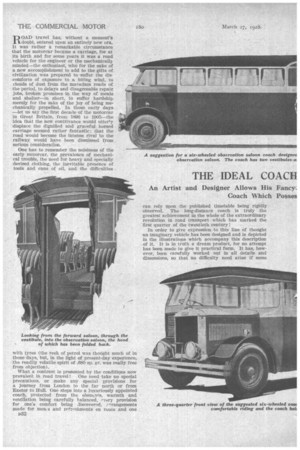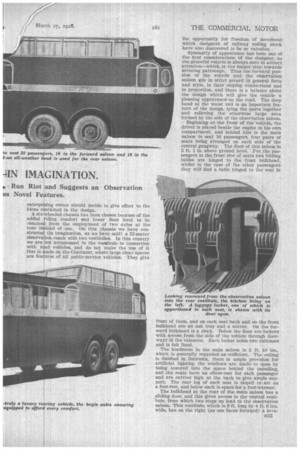THE IDEAL COACH 4IN IMAGINATION.
Page 94

Page 95

Page 96

If you've noticed an error in this article please click here to report it so we can fix it.
An Artist and Designer Allows His Fancy-.
Coach Which Posses Run Riot and Suggests an Observation es Novel Features.
ROAD travel has, without a moment's Ldoubt, entered upon an entirely new era. Ft was rather a remarkable circumstance that the motorcar became a carriage, for at its birth and for some years it was a road vehicle for the engineer or the mechanically minded—the enthusiast, who for the sake of a new accomplishment to add to the gifts of civilization was prepared to suffer the din comforts of exposure to a biting wind, to clouds of dust from the macadam roads of the period, to delays and disagreeable repair jobs, broken promises in the way of meals and shelter—in short, to suffer hardship merely for the sake of the joy of being mechanically propelled. In those early days —let us say the first decade of the motorcar in Great Britain, from 1896 to 1905—the idea that the new contrivance would utterly displace the dignified and graceful horsed carriage seemed rather fantastic : that the road would become the intense rival to the railway would have been dismissed from serious Considera Lion.
One has to remember the noisiness of the early motorcar, the prevalence of mechanical trouble, the need for heavy and specially devised clothing, the inevitable presence of tools and cans of oil, and the difficulties with tyres (the reek of petrol was thought much of in those days, but, in the light of present-day experience, the readily volatile spirit of .680 sp. gr. was really free from objection).
What a contrast is presented by the conditions now
prevalent in road travel One need take no special precautions, or make any special provisions for a journey from London to the far north or from Exeter to Hull. One steps into a luxuriously appointed coach, protected from the eleinclif.F.i, warmth and ventilation being carefully balanced, l*very provision for one's comfort being discovered, .!!.,•rangements made for mea:s and refr.,?shments en route and one
D32 can rely upon the published timetable being rigidly observed. The long-distance coach is truly the greatest achievement in the whole of the extraordinary revolution in road transport which has marked the first quarter of the twentieth century : In order to give expression to this line of thought an imaginary vehicle has been designed and is depleted in the illustrations which accompany this description of it. It is in truth a dream product, for no attempt has been made to give it practical form. It has, however, been carefully worked out in all details and dimensions, so that no difficulty need arise if some enterpr sing owner should decide to give effect to the ideas c ntained in the design.
A six wheeled chassis has been chosen because of the added riding comfort and lower floor level to be obtaine 1 from the employment of two axles at the rear in tead of one.On this Chassis we have constructeL (in imagination, as we have said) a 32-seater observalion coach with two vestibules. In this country we are not accustomed to the vestibule in connection with road vehicles, . and do not make the use of it that is made on the Continent, where large clear spaces are features of all public-service vehicles. They give
the opportunity -for freedom of movement which designer's of railway rolling stock have also discovered to be so valuable.
Symmetry of appearance has been one of the first considerations of the designer, as the graceful vehicle is always sure to attract :attention—which is the longer step towards securing patronage. Thus the forward position of the vehicle and the observation saloon are in strict accord in general form and style, in their sloping windscreens and in proportion, and there is a balance about the design which will give the vehicle a pleasing appearance on the road. The deep band at the waist rail is an important feature of the design, tying the parts together and relieving the otherwise large area formed by the side of the observation saloon. Beginning at the front of the vehicle, the driver is placed beside the engine in his own compartment, and behind him is the main saloon to seat 16 passengers, four pairs of seats being arranged on each side of the central gangway. The floor of this saloon is 2 ft. 1 in. above ground level. For the passengers in the front row of seats two folding tables are hinged to the front bulkhead, whilst in the case of the other passengers they will find a table hinged to the seat in front of them, and on each seat back and on the front bulkhead are an ash tray and a mirror. On the forward bulkhead is a clock. Below the floor are lockers with access from the side of the vehicle through doorways in the valances. Each locker holds two suitcases and is felt lined.
The headroom in the main saloon is 5 ft. 10 ins., which is generally regarded as sufficient. The ceiling is finished in lincrusta, there is ample provision for artificial lighting, the windows are made to open by being lowered into the space behind the panelling, and the seats have an elbow-rest for eaCh passenger and are carried high at the back to give ample support. The rear leg of each seat is sloped to act as a foot-rest, and below each is space for a foot-warmer.
The bulkhead at the rear of the main saloon has a sliding door, and this gives access to the central vestibule, from which two steps up lead to the observation saloon. This vestibule, which is 3 ft. long by 4 ft. Gins. wide, has on the right (as one faces forward) a la va
tory closed by a door and on the left an entrance closed by a door, 2 ft. wide, opening outwards, a shelf filling the Odd corner. There is room here, if necessary, for a loose seat for a conductor or steward. In place of the shelf a useful cupboard could be fitted. The petrol tank is carried between the frame members, and the filler orifice is brought to a position below this shelf or cupboard and is rendered accessible for replenishment purposes by a small flap opening from the outside. The lavatory is 3 ft. long by 2 ft. 9 ins. wide, and is equipped with a wash-basin (fed from a water tank below the roof) and a chemical w.c.
The floor of the observation saloon is only 3 ft. 9 ins, above ground level and the seat platforms are raised another 10 ins. above the level of the central gangway. In this space four lockers for luggage are provided, having fall-front doors. Ample space is thus available in the vehicle for the disposal of the whole of the luggage of each passenger and, moreover, it is so stowed that each suitcase is in the locker immediately below where its owner is seated and can be reached with the least possible disturbance or inconvenience should it be needed en route. The locker floors have a slight slope outwards.
The arrangement for seating, tables and other equipment is similar in the observation saloon to that in the main saloon. This is in very truth an observation saloon, for it is equipped with an all-weather head, the rigid frames holding glass panels, the front being divided and acting as a two-piece windscreen. The shaped side panels at the front of the saloon are fixed, the three next to them are ordinary drop windows and the rearmbst ones are of the half-sliding type. The all-weather hood when folded back has a bed-place above the roof of the rear vestibule. Below this Is the water-tank to supply the kitchen, its filling orifice being accessible through a trap in the hood bed.
Two, steps lead down into the rear vestibule, which
is 3 ft. long and 4 ft. 6 ins. wide, 'with a kitchen 3 ft., square on the off side. The floor of the kitchen is 9 ins. lower than the vestibule door. It is equipped with a stove, sink and cupboards. From the vestibule a door on the left gives entrance and exit so that the passengers from each saloon can pass in or out without obstructing the others.
The overall height of the vehicle with the hood in the closed position is 10 ft. 6 ins. The overall length of the body is 25 ft. 6 ins., the forward saloon being 9 ft. 6 ine, long, the observation saloon 9 ft. 9 ins, and the steps are 1 ft. 3 MS, from the ground.
We can imagine our imaginary coach making a very strong appeal to the traveller who prefers to cover his middle and longdistance journeys by, road instead of by rail, and to the tourist, who would see in it the ideal way of seeing the country, with the assurance of full pirotection and ample comfort it the weather be inclement, and of the glorious air if it be fine and sunny. In our imagination we are touring Scotland in such a vehicle and recalling the beauties of loch, moor, mountain and glen, and heartily wishing we were doing so in reality I The observation coach, by which name is known the type of passenger-Carrying vehicle which has a raised saloon at the rear, has emanated from the United States of America and has quickly been adopted in this country because it is able to cater for the fancies and predelictions of passengers by giving a roof over those who like complete overhead protection and an open-roof saloon for those who love the sun and all the air that is obtainable, whilst the hood is there to close in the second saloon when the weather so demands. For Continental tours we regard the observation coach as being peculiarly suitable, and particularly when some such design as that which is portrayed in this article is adopted, with its ample luggage space, its vestibules, kitchen and lavatory, and, on its six wheels, running smoothly over occasional bad surfaces.




























































































































































































